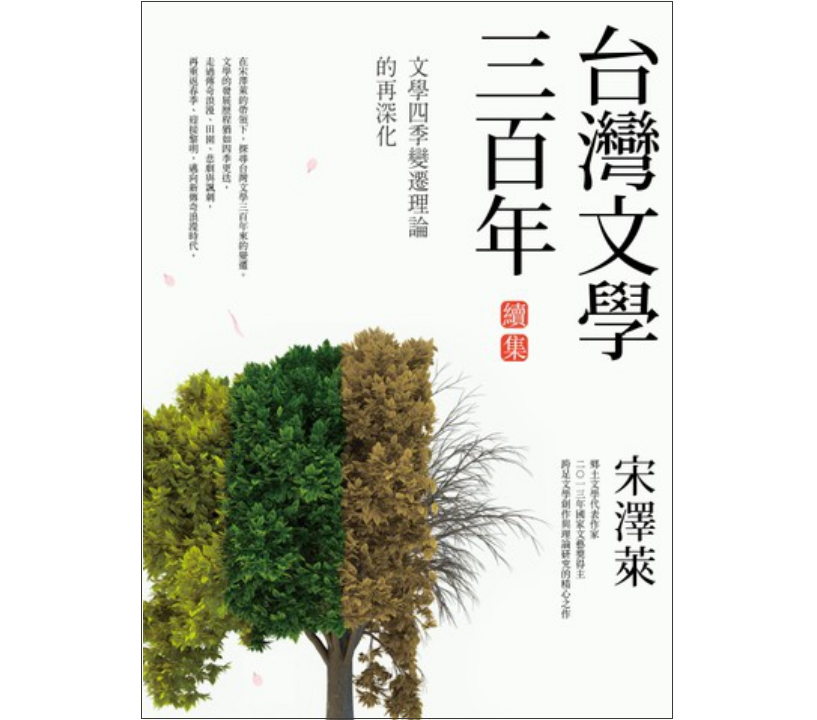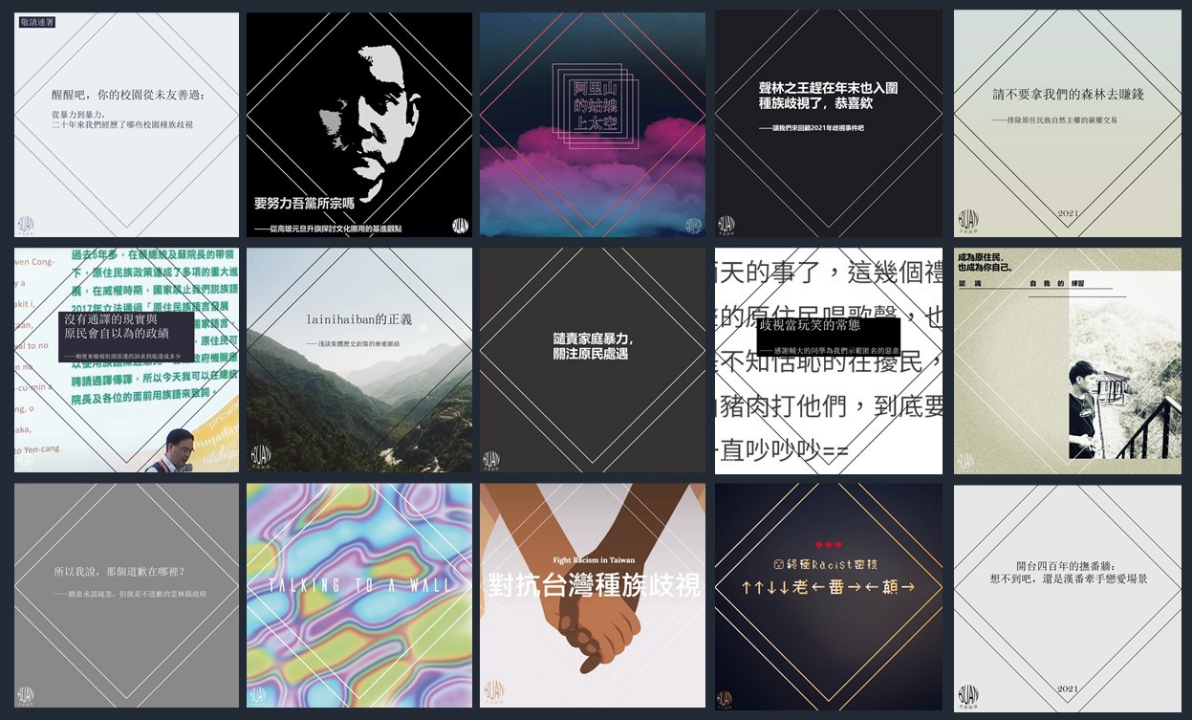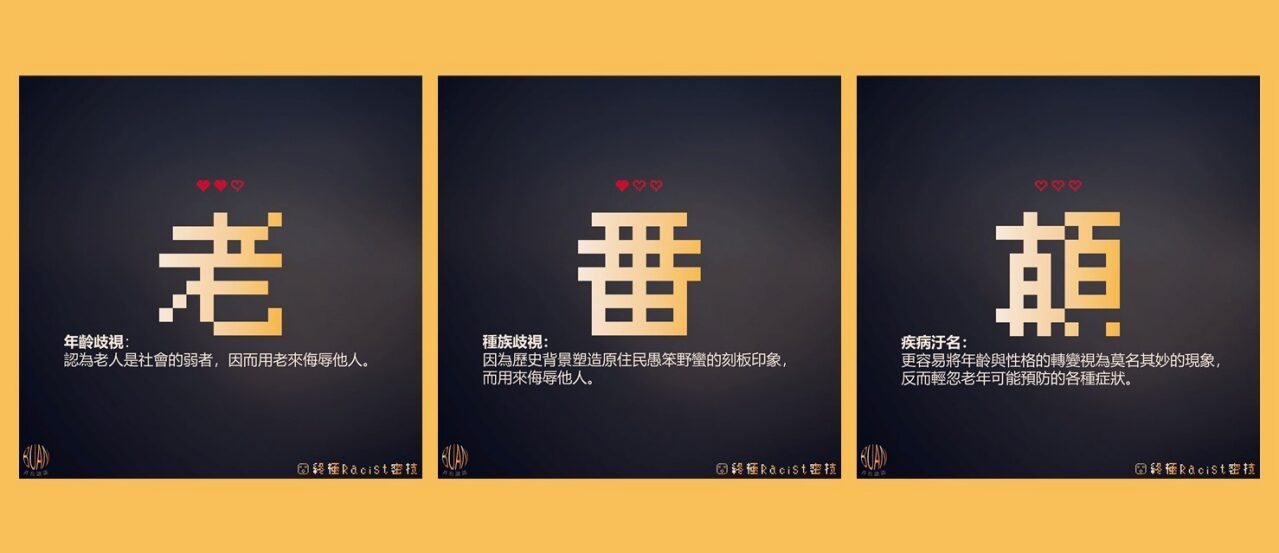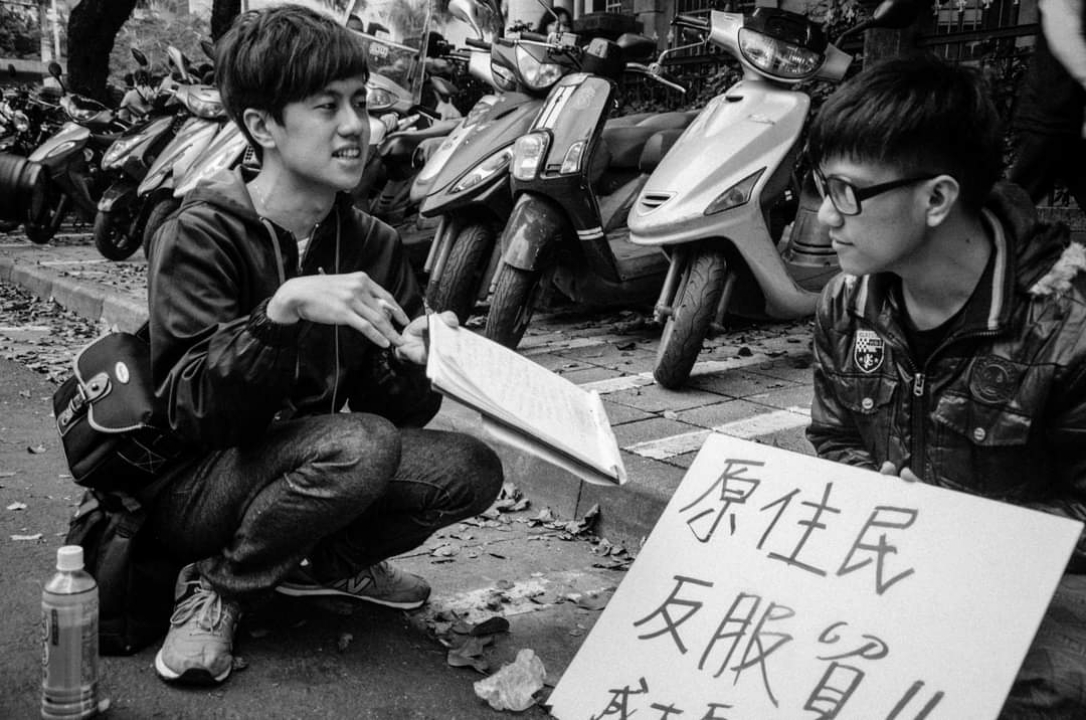――「Buan 月亮說話 月亮曆」(簡稱「月亮說話」)
創立於2020年7月,「月亮說話」將Facebook和Instagram作為社群媒介,分享以原住民族議題為主的內容,不只積極回應、評論新聞時事,也產製相關政策倡議、文化傳遞等圖文創作,邀請大家一同在平台上開啟討論。貼文觸及的面向既廣且深,仰賴清晰的思辨和寫作能力,更需要長期關注原民議題。而這樣多元複雜的工作,幕後僅由一名布農族年輕人Talum Ispalidav所經營。
「我會覺得我是一個以文字做刀、用批判做書寫的平台。」觀察到性質相似的自媒體大多傳遞正能量,Talum坦承自己的內容較為晦澀,甚至偶爾可能還帶有情緒,而這也很真實地反映在他所關注的議題上。月亮(布農語:Buan)是布農族文化中的重要媒介,藉由文字,月亮開口說話,持續輸出原民議題的批判觀點,堅定的聲音時而溫柔理性,也在必要時憤怒。
Talum,布農人,「月亮說話」的經營者,目前正就讀於國立臺南大學國語文學系碩士班,對文字敏感的他,平常也寫詩。讀大學時接觸到原住民族社團,親身參與相關運動,後加入原住民族青年陣線擔任線上小編,這也為他日後創辦社群累積了不少經驗。不過,談到平台的成立契機,最早或許可以追溯到國高中時期,因為原住民身分加分而受嘲諷的自身經歷。日後回想,這讓他開始覺得,如果連自己都不知道怎樣跟別人溝通,要如何面對歧視?

「我在參與原住民族運動時,才慢慢思考我身為原住民到底意味著什麼。」以自身經驗為例,Talum認為很多人在成長的過程中,被灌輸了許多關於原住民的刻板印象,無論是否符合既定印象都可能招致嘲弄,追尋自我認同的過程充滿挫折。「認同自己成為原住民,去理解原住民的能動性、在社會中的階級地位、對自己的歷史產生認同,這段過程蠻特殊的。並不只是文化,是對於原住民族歷史現況的一種負疚感,覺得自己應該要做到更好,把過去被佔領的追回來。」
「月亮說話」遂成為他讓自己慢慢地、迂迴地回到部落的路徑,是一種自我探索的文化實踐。
 宋澤萊在其著作《台灣文學三百年(續集):文學四季變遷理論的再深化》中,將文學四季遞嬗理論套用至文學發展脈絡,基於這個論調認為原住民族文學尚未到達屬於諷刺文學的「冬季」。圖©前衛出版社
宋澤萊在其著作《台灣文學三百年(續集):文學四季變遷理論的再深化》中,將文學四季遞嬗理論套用至文學發展脈絡,基於這個論調認為原住民族文學尚未到達屬於諷刺文學的「冬季」。圖©前衛出版社
另一個創立的理由,和文學密不可分――事實上,Talum為「月亮說話」選擇的平台分類,就是「文學藝術」。作家宋澤萊在《台灣文學三百年(續集):文學四季變遷理論的再深化》中,將四季的遞嬗理論套用至臺灣文學的發展脈絡,引用馬列雅弗斯.莫那能(Malieyafusi Monaneng)、瓦歷斯.諾幹(Walis Nokan)等作家,認為原住民族文學花太多時間在訴說悲情,還沒能跨出訴說悲情的「秋季」,進而遞嬗至屬於諷刺文學的「冬季」。1 Talum不認同這個觀點,曾與宋澤萊在線上展開爭論,表示原住民族文學之所以是大家看到的「悲情」,是因為「原民性本身就具備溝通對話與抗爭的性格」,而原住民族運動的兩大訴求:還我土地、我要自治,直到現在都還未真正達成。對他而言,原住民族文學並非訴諸悲情,而是「用文學去講出、虛構出我們的事實,因為這些真實情況本就存在。」
他進一步指出,隨著時代改變,當代的原住民族文學作品如馬翊航《山地話/珊蒂化》、程廷《我長在打開的樹洞》,已不同於所謂的「經典」形象,將更多細膩、私密的經驗編入族群歷史中,呈現出更多元的樣貌。這種對文學的理解和興趣,轉向至社群經營:「我會做這樣的社群平台,是想讓大家看到,當代原住民族不同人的面貌是不一樣的……這是個嘗試,結合原住民族文學跟當代原住民族運動的發展,基進、不畏抗爭,對我而言本來就是原住民族的性格展現。」
「月亮說話」的內容由Talum獨立規劃,作法是先設定探討議題,思考自己對議題的關注程度,再從相關新聞中找到著力點進行論述,目前多為關注原住民族正名、反歧視法、土地及海域法等議題的推進,必要時更會隨時回應時事。同時身兼老闆與小編的他,雖然可以隨心所欲地執行,但由於只有一人,也擔心產生權威偏誤和觀點的侷限性,因此經常尋求朋友的外部視角給予建議與回饋。最終的目標,是希望能將社群開放出去、讓更多人參與進來,使社群本身形成一個好的生態,達到近似自我療癒的效果。
「大家會在網路上關注議題,實際上在現實中做倡議,力量還是很微小,有時候會覺得蠻無力的。」Talum分享自己曾一度產生嚴重的怠惰感,越瞭解原住民族的歷史脈絡後,越會感到深沉的悲傷和無力,甚至質疑自己所做的事,一切是否依然停滯不前?他認為這些可能都是當代原住民的正常情緒,久了之後已經調適,甚至轉化為平台的創作素材,以覺察練習等方式進行社群分享。
 「Buan 月亮說話 月亮曆」以時事評論、政策倡議、族群共好為主要經營方針,Talum Ispalidav時常以懶人包的形式,梳理複雜而多元的議題。圖片取自「Buan 月亮說話 月亮曆」中部份議題懶人包的封面。圖/臺灣當代文化實驗場整理
「Buan 月亮說話 月亮曆」以時事評論、政策倡議、族群共好為主要經營方針,Talum Ispalidav時常以懶人包的形式,梳理複雜而多元的議題。圖片取自「Buan 月亮說話 月亮曆」中部份議題懶人包的封面。圖/臺灣當代文化實驗場整理
當然,「月亮說話」也獲得過不少正面迴響,更實質促成了一些改變。曾有一群同學主動向Talum尋求合作,眾人合力把「加分政策」的脈絡與細節整理出來,也有很多朋友藉此分享自己的生命經驗,對他來說是很感動的經驗。「倡議平台難做,第一是對議題的期待不同,第二是深度內容對一些人可能有點困難,所以我不會期待發展到很大的規模,但至少開始有人願意去理解、深入討論。」
2021年,藝人Ella在國片《聽見歌再唱》的記者會上失言2,「月亮說話」對此在網路上展開批判,進而直接或間接地致使Ella和製作團隊火速道歉。Talum表示,特別提起這件事,是因為這是非常好的正面道歉範例,過程中沒有推卸責任,純粹就其說過的話坦承錯誤。與之相對的是,去年金鐘獎有媒體看到原住民穿族服就報導露屁股3,至今仍然沒有媒體為此道歉。面對生活當中可見或不可見的歧視,他也製作相關圖卡加以傳播宣導:「在我的成長經驗裡,沒有關於種族歧視的教材,所以我才會做,也有朋友說以前隱約感覺到,看到教材才發現臺灣真的有歧視,這好像是需要被確定的一件事。」
「月亮說話」的初期構想階段,Talum試圖以布農語單字詮釋當代文學作品中的文句,用別於大多數文學作品以漢人視角來看原住民,創造出一種翻轉的切入角度。然而,這樣的產出需要大量準備工作,一人難以負荷,相較之下,探討議題雖然也需要爬梳資料,但因為議題涉及的公共性,而更加容易收穫關注和討論。於是平台逐漸轉型,從原本的做法改為結合概念的專題呈現:比如將原住民族的永續發展與環保概念搭配,呼籲將弱勢族群的聲音也納入氣候決策;或者翻轉漢字的邏輯結構,例如人們可能在使用上得過且過的「老番顛」一詞,實則同時隱含了年齡、種族與疾病污名的複合歧視等。
 Talum Ispalidav提到,人們可能在使用上得過且過的「老番顛」一詞,實則同時隱含了年齡、種族與疾病污名的複合歧視等,圖片取自「Buan 月亮說話 月亮曆」。圖/臺灣當代文化實驗場整理
Talum Ispalidav提到,人們可能在使用上得過且過的「老番顛」一詞,實則同時隱含了年齡、種族與疾病污名的複合歧視等,圖片取自「Buan 月亮說話 月亮曆」。圖/臺灣當代文化實驗場整理
「即使可能無法促成和解,但可以讓大家理解有些傷痕仍然存在,最困難的是如何聆聽彼此的經驗。」網路交流的衝突似乎在所難免,以加分政策的討論而言,曾有人留言表示原住民就是既得利益者,甚至跳針回覆「的啦、的啦」來嘲諷。遇上不講理、無法溝通的人,Talum坦言曾不小心「爆氣」,也笑稱自己喜歡和大家吵架,「憤怒小編」的名號不脛而走。他笑說,雖然自己現在還是會跟他們吵,但會覺得比較理解對方了,也因此開始思考更多平台能做到的事。「這很重要,雖然無法溝通,但有人願意用較理性的態度進行溝通的話,我們都是很開放的,至少做到互相理解彼此的憤怒,這已經很不容易了。」

延續這樣的想法,Talum將媒體作為賦權與集體創傷療癒的一種路徑,而在找到療癒的方法之前,得先知道哪裡受傷、為什麼受傷。總的來說,「月亮說話」嘗試為受歧視且不知如何面對的人提供了一些思考方法,討論政策如何修正,而不是指責被政策壓迫的人,從倡議的角度,試著在體制內促成改變。
談到族名的問題,他以名字不容易唸的中華職棒選手Giljegiljaw Kungkuan為例,即使本人已經說過可以稱之Giyab或Gili,媒體普遍都還是寫成漢譯的「吉力吉撈」;面對一時難以更改的語用習慣,作法就會是倡議讓大家理解命名規則、認識各族拼音的習慣,不會唸也應該尊重族人意願,讓他們可以單列族名在證件上。
「臺灣的原住民族曾經有可能像加拿大第一民族,做到跟立法院平行的原住民族議會體制。」Talum坦言,因為社群平台本身的限制,自己在賦權的部分做得還不夠,也期待未來能有系統性的課程,「不只是知識上的建構,去打開想像,做政治上的賦權,大家會想做些比投票或抗議更多的事情,也藉此彼此療癒那些過往的傷痕。」
採訪中,Talum經常半開玩笑地抱怨經營社群平台的辛苦,表面上感覺狀態搖擺不定,但當他在論述自己的理念時,其實是相當堅定而充滿自信的。
關於和「月亮說話」類似性質的自媒體,Talum提到了友站「每天來點布農語啊!mapasnava Bunun saikin」、「親愛的漢人」等。此外,他本人也數次受邀參與原民台節目《Lima幫幫忙》,談論歧視、正負能量、刻板印象等主題,這些或自發或受邀的參與,也一再證明了Talum和其他參與者們,是如何用各自的力量,試圖為自己關注、在意的事務盡心的努力。